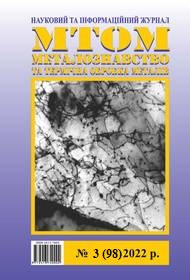FEATURES OF THE CRACKS’ FORMATION IN HETEROPHASE INCLUSIONS OF THE “DISPERSED PHASES IN A NON-METALLIC MATRIX” TYPE
DOI:
https://doi.org/10.30838/J.PMHTM.2413.270922.13.900Keywords:
steel; non-metallic inclusions; cracks; phases; interphase boundariesAbstract
The purpose of the article − to study of crack nucleation features in heterophase inclusions of the “dispersed phases in a non-metallic matrix” type under the conditions of steels’ plastic deformation. Methods. The research was conducted after deformation for a number of different grades steel samples in the temperature range of 20...1 200 °С on Instron-1195 and IMASH-5C with special grippers, with a gripper movement speed of 1 680 mm/min. Research methods were used: petrography, micro-X-ray spectral analysis (Cameca MS-4, Nanolab-7), optical microscopy (Neophot-21). Results. It is shown that the variety of phases composing the heterophase inclusions "dispersed phases in non-metallic matrix" leads to their different behaviour under plastic deformation conditions. At the same time, the nucleation of brittle or viscous microcracks occurs along the internal interphase boundaries between the "non-metallic" matrix and the dispersed particles of the second phase. The cracks’ character near the inclusions determined by the plasticity level of “matri” and dispersed phases of inclusions and the deformation temperature are revealed. The determined critical degrees of samples’ deformation, upon reaching which appreciable microcracks along the internal interphase boundaries occurred, were depend on temperature and the nature of the “dispersed phases in a non-metallic matrix” inclusions. Scientific novelty. The features of microcracks nucleation associated with heterophase inclusions of the “dispersed phases in non-metallic matrix” type with different combination of brittle and plastic phases during steels’ deformation are determined. The types of microcracks occurring in inclusions of the “dispersed phases in the non-metallic matrix” type and the locations of their formation have been determined. It is shown that the values of the deformation critical degrees determine the level of cohesive strength for internal interphase boundaries in heterophase inclusions “dispersed phases in a non-metallic matrix” at different deformation temperatures. Practical value. The use of the obtained results will make it possible to develop technologies for producing steels with regulated types of non-metallic heterophase inclusions that will allow to increase significantly their technological and operational characteristics, and also to prevent the formation of various defects in the steels' treatment by pressure and the operation of products.
Downloads
Published
Issue
Section
License
Authors that are published in this journal agree to follow the conditions:
Authors reserve the right to the authorship of his work and cede the right to the journal of first publication of this work on conditions of the license under the Creative Commons Attribution License, which allows others to distribute it freely with the obligatory reference to the author of the original work and the first publication of the work in this journal.

